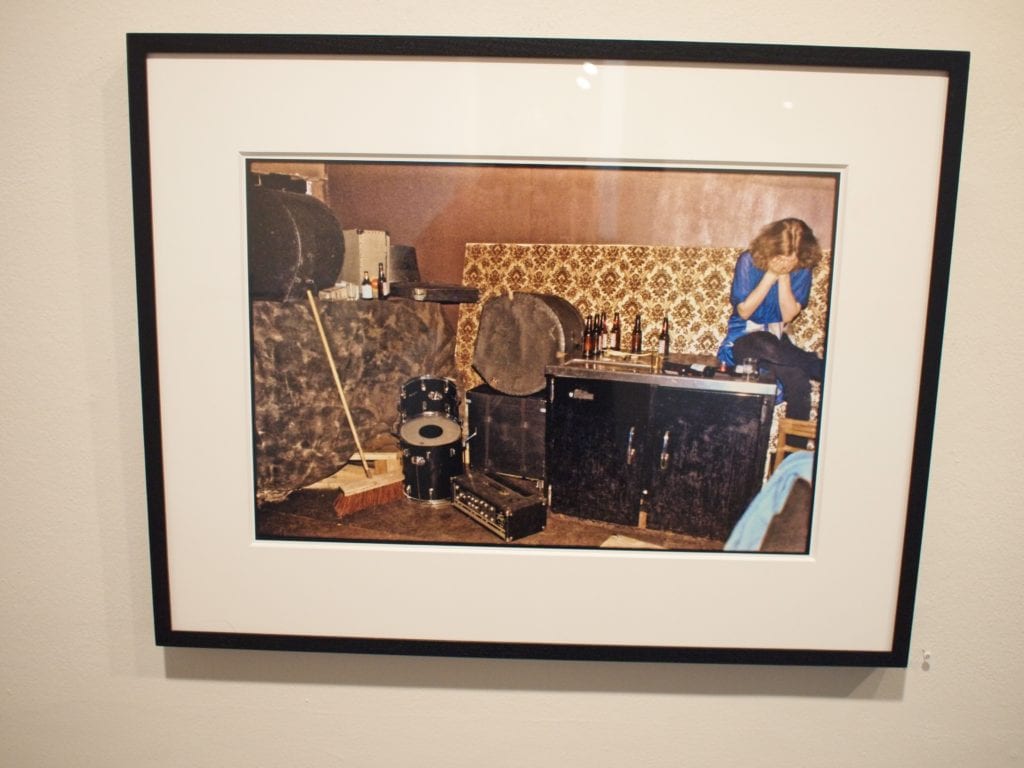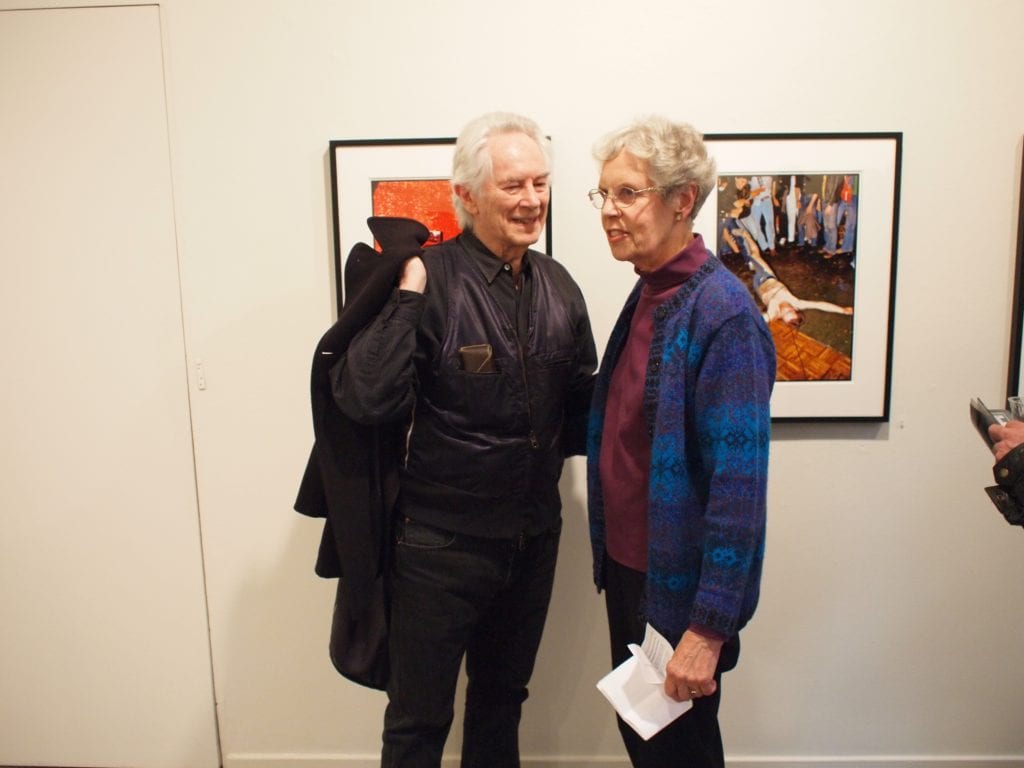
By Murray Schneider
Admirers of the photography of Bruce Conner gathered together on March 3 for an evening reception at the Gallery Paule Anglim, which premiered 13 color photographs edited and transferred to digital color format by the Glen Park avant-garde artist before his death in 2008.
The exhibit, “Mabuhay Gardens: Punk Photography & Collage,” is a record of the San Francisco Punk Rock scene. It will remain at the Geary Street gallery through March 31st when it moves to the Museum of Contemporary Art in Denver as part of an exhibition, “Bruce Conner and the Primal Scene of Punk Rock.”
As the gallery filled, Sussex Street’s Jean Conner greeted friends of hers, and of her late husband.
“There are lots of familiar faces here,” she said, as she chatted with poet and playwright Michael McClure, who attended Wichita State University with Bruce Conner.
“The spread of Bruce Conner’s work was great,” said McClure, dressed as stylishly as he had for the 1960s photograph taken outside City Lights Books that captured him standing along side Robbie Robertson, Bob Dylan and Allen Ginsberg.

“Bruce’s range of skills spanned painting to sculpture,” said McClure, whose play “The Beard” debuted at the Actor’s Workshop in December 1965.
Gallery curator Ed Gilbert studied Conner’s freshly mounted images, which hung beneath pinpoint lighting.
“Bruce created more than photographs,” said Gilbert, who has worked at Gallery Paule Anglim for 25 years. “He worked in every medium, handling everything differently.”
Gilbert walked up to a Conner color print, “Liars Guitar.”
“Bruce was an observer as well as participant,” he recalled, “He once took a photo at Mabuhay Gardens and fell from the stage and sprained an ankle.”
The Mabuhay Gardens, a North Beach Filipino restaurant on Broadway, became the unlikely venue for the 1970s burgeoning punk rock scene in San Francisco. It featured counter culture local bands such as the Mutants, Negative Trend and the Avengers.
Known as the “Fab Mab,” the Broadway club caught the attention of Conner, whose well-schooled eye was attracted to the unusual and the experimental.
“Bruce became involved in the earliest “Beat” scene,” said V. Vale, publisher of “Search and Destroy,” the fanzine that chronicled the North Beach punk scene 25 years after McClure read his poems at Fillmore Street’s Six Gallery in 1955.
Vale snapped digital shots of several of Conner’s photographs, many of which, like “De Detroit: UXA,” appeared in “Search and Destroy.”
“I met Bruce in 1968 when I worked at City Lights,” said Vale, whose magazine was seeded with $100 from both Lawrence Ferlinghetti and Allen Ginsburg. “Bruce was already involved in the underground film scene and I told him I could get him a press pass.”
Conner’s film, “Crossroads,” which depicted slow-motion explosions of a hydrogen bomb exploding over a Pacific atoll, may be his most famous movie.
Born in 1933, Conner moved to San Francisco after his marriage in 1957 just as the Beat scene of poets, writers, and artists was emerging.
“These movements come in waves,” said Vale, who still lives only steps from City Lights. “First the Beats, then the Hippies, then Punk Rock. Bruce was there to capture it all.”
As was his wife Jean Conner, an accomplished artist herself.
“Michael McClure lived a Fillmore Street apartment building with other artists,” she remembered. “Bruce and I moved around the corner on Jackson Street, and we all became involved the City Lights art scene.”
Conner’s work is housed in the permanent collections of several museums, including New York’s MoMA, the Whitney Museum, the National Gallery of Art in Washington and SFMoMA, and in 2000 his eclectic work was displayed at the deYoung for three months.
His oeuvre is no stranger in the village either.
When Bird and Beckett was situated at its former Diamond Street location, bookseller Eric Whittington worked hand-in-hand with Conner.
“Two of Bruce’s films, “Marilyn x 5,” and “Breakaway” were screened here in 2000, said Whittington. “And we hung several of his Fallen Leaf inkblot drawings after 9/11.”
“Some of Bruce’s collages hung at Café ?, which is now Café Bello,” said Jean Conner. “A group of six neighbors who all lived on Sussex Street between Diamond and Castro called themselves ‘The Blockheads’ and their work was displayed throughout the neighborhood.”
“Bruce was absolutely one of the great imaginative artists,” offered Whittington. “He would not stick with one identifiable niche.”
Never at a loss for words, Michael McClure chimed in:
“Bruce Conner’s spectrum of skills – collage, film, photography, sculpture, painting and sketching – is huge. He’s our closest thing to Leonardo.”
That’s daVinci, not diCaprio.
Those interested can purchase the book, “2000 BC: The Bruce Conner Story – Part II,” at Bird and Beckett Books and Records. This volume accompanied the 2000 de Young Museum Bruce Conner exhibit. Also, “Looking for Bruce Conner,” by Kevin Hatch is scheduled for publication in 2012.